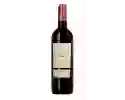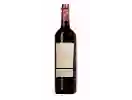
Château de MalfouratLa Closerie Pécharmant
This wine generally goes well with
Details and technical informations about Château de Malfourat's La Closerie Pécharmant.
Discover the grape variety: Arbane
Arbane or arbanne is a very old white grape variety from the north/east of France, coming from the Aube and more precisely from the Champagne region. The Comité Interprofessionnel des Vins de Champagne wishes to preserve the use of traditional grape varieties of Champagne. The Arbane is a small bunch of grapes with small berries and a very sweet pulp, a late variety that needs sun and heat to concentrate all its sugars. It gives a wine rich in alcohol, elegant and nervous, with a floral nose and a nice acidity.
Last vintages of this wine
The best vintages of La Closerie Pécharmant from Château de Malfourat are 2015
Informations about the Château de Malfourat
The Château de Malfourat is one of of the world's greatest estates. It offers 7 wines for sale in the of Pécharmant to come and discover on site or to buy online.
The wine region of Pécharmant
The wine region of Pécharmant is located in the region of Guyenne of South West of France. Wineries and vineyards like the Château de Tiregand or the Château Terre Vieille produce mainly wines red, white and sweet. The most planted grape varieties in the region of Pécharmant are Merlot, Cabernet-Sauvignon and Cabernet franc, they are then used in wines in blends or as a single variety. On the nose of Pécharmant often reveals types of flavors of non oak, plum or dark fruit and sometimes also flavors of black fruits, black cherries or cedar.
The wine region of South West
The South-West is a large territorial area of France, comprising the administrative regions of Aquitaine, Limousin and Midi-Pyrénées. However, as far as the French wine area is concerned, the South-West region is a little less clear-cut, as it excludes Bordeaux - a wine region so productive that it is de facto an area in its own right. The wines of the South West have a Long and eventful history. The local rivers play a key role, as they were the main trade routes to bring wines from traditional regions such as Cahors, Bergerac, Buzet and Gaillac to their markets.
The word of the wine: Varietal
Said of wine aromas that are reminiscent of fresh grapes. The most demonstrative example is certainly that of wines made from the Muscat grape variety.














